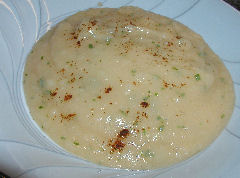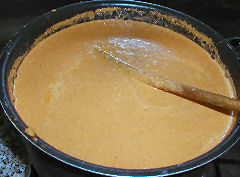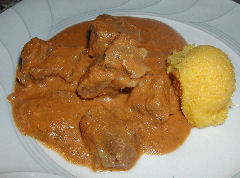Cua nque’ msaa”
– “Good Morning” in the Chatino language
Buenos Aires – And a good morning in English as well. I decided to split the Casa SaltShaker dinner this week up into parts. Not for the people eating it, they get to dine continuously on the five courses, but in terms of presenting it. That way I avoid the long, meandering post that I usually do on Sunday or Monday mornings, and it also responds to the apparently quite eager folk that I’ve been getting e-mail from in regard to one of the courses. This weekend, the event that caught my eye as a theme was La Noche de Rabanos, or The Night of Radishes. I don’t know alot about it, other than it doesn’t seem to involve the eating of radishes, but more the looking at them. Local artists in various Oaxacan communities in Mexico apparently carve the radishes into fanciful scenes – some of them quite elaborate – many of them related to christmas and the nativity. If you do an internet search, you’ll find plenty of fascinating examples. From there, I simply took a look at some of the multitude of Oaxacan dishes and came up with a menu. What I’m going to present today, are two of the five dishes – the two which are being cooked and presented identically all three nights that we’re doing this festival at the Casa (we expanded by a day, there was much demand for both this week and next during “the holidays”, boosted by the New York Times article that appeared about us last weekend.
First, Oaxacan cuisine is quite varied – the population of the region numbers a bit over 3.3 million and is made up of at least 15 different distinct ethnic communities, all with their own traditions, dress, and cooking. What I’d guess most of us know about Oaxacan cuisine is pretty much what I knew about it (and still don’t don’t much more) – and that’s mole. Many of us have heard of the Seven Classic Oaxacan Moles… usually spoken of in capitals like that, as if they were sacrosanct. However, what became interesting as I started to look into it is that no one agrees on the seven classics. Everyone cites the number seven, and then mentions that there are a whole lot more, and “these seven” are the most important. I’d guess most folk agree on negro, amarillo, verde, and colorado for four sort of core ones, but beyond that, it seems to be influenced by their own personal experiences. If one were to combine even the first couple of dozen results from a simple google search of “seven classic oaxacan moles”, you end up with somewhere around fifteen different moles!
That’s good, by the way, because it meant I could play around alot more. I started by thoroughly reading the Oaxacan sections of my favorite Mexican cookbook, The Essential Cuisines of Mexico by Diana Kennedy – and it is an essential book to understand something about the cuisines of Mexico. And, if you don’t know Diana Kennedy, you should get out there and start reading her works.
 Back to the food, and two of the dishes. The first dish is a bit of a cheat, and I know it, but it was one I wanted to feature. It’s a dish I got years ago from a friend who lives near Oaxaca. Technically, however, he comes from the Yucatan, near Cancun, and a bit of research shows that the origin of this soup is that area, not Oaxaca. So it’s only Oaxacan by way of transplant. Nonetheless, it’s a great summer soup, and I’ve modified it a bit over the years. What I did do this time, and will continue to do in the future as I like the result, is combine a Oaxacan herbal influence… The original soup is a simple room temperature or chilled soup of potato, cantaloupe, sherry, and half and half. It’s very refreshing. I’ve lightened it up over time by using milk rather than half and half, I also like it with a touch of spice, so I generally add a bit of chipotle pepper (smoked, dried jalapeños) to it. The new touch is that apparently the use of watercress, or the local equivalent, with melons is a local tradition in Oaxaca, so I added watercress to the soup as well. It’s really quite simple – boil half a dozen potatoes, drain them but reserve the potato water. Add the flesh of a cantaloupe, a pint of milk, a half teaspoon of chipotle powder, and a handful of watercress leaves. Puree with a hand blender, adding in some of the potato water until you get a nice, thick soup consistency. Go slightly thinner than you want it to turn out in the end, as when you chill this, it will thicken up considerably. Wait until it’s chilled to adjust the seasoning – add salt and more chipotle if you like – the chilling changes the intensity of the seasoning. You can serve this with a dollop of sour cream atop as well – and a light dusting of chipotle pepper as here makes it all pretty… I’m leaving this soup as is all three nights (a fresh batch each day, but no changes).
Back to the food, and two of the dishes. The first dish is a bit of a cheat, and I know it, but it was one I wanted to feature. It’s a dish I got years ago from a friend who lives near Oaxaca. Technically, however, he comes from the Yucatan, near Cancun, and a bit of research shows that the origin of this soup is that area, not Oaxaca. So it’s only Oaxacan by way of transplant. Nonetheless, it’s a great summer soup, and I’ve modified it a bit over the years. What I did do this time, and will continue to do in the future as I like the result, is combine a Oaxacan herbal influence… The original soup is a simple room temperature or chilled soup of potato, cantaloupe, sherry, and half and half. It’s very refreshing. I’ve lightened it up over time by using milk rather than half and half, I also like it with a touch of spice, so I generally add a bit of chipotle pepper (smoked, dried jalapeños) to it. The new touch is that apparently the use of watercress, or the local equivalent, with melons is a local tradition in Oaxaca, so I added watercress to the soup as well. It’s really quite simple – boil half a dozen potatoes, drain them but reserve the potato water. Add the flesh of a cantaloupe, a pint of milk, a half teaspoon of chipotle powder, and a handful of watercress leaves. Puree with a hand blender, adding in some of the potato water until you get a nice, thick soup consistency. Go slightly thinner than you want it to turn out in the end, as when you chill this, it will thicken up considerably. Wait until it’s chilled to adjust the seasoning – add salt and more chipotle if you like – the chilling changes the intensity of the seasoning. You can serve this with a dollop of sour cream atop as well – and a light dusting of chipotle pepper as here makes it all pretty… I’m leaving this soup as is all three nights (a fresh batch each day, but no changes).
 The Chatino people are one of the indigenous groups in Oaxaca – with about 23,000 members known. I haven’t done a lot of research on them. A google search reveals nothing but my menu posting for “chatino mole” or “mole chatino”. Diana Kennedy talks a bit about it in the above mentioned book, and gives a recipe, but doesn’t really talk about its origins. There are clearly moles made by folks from the Chatino people, but I’m going to have to leave the origins of this recipe pretty much with Diana and her statement that she got it from a young chef in the area. What I can tell you is that it’s amazingly rich, decadent, and oh so good. It doesn’t involve chocolate – I know some folks think chocolate is some sort of defining element of mole, but that’s a myth, it’s specific to a couple of types of mole. I really didn’t make much in the way of any modifications to this recipe with one exception –
The Chatino people are one of the indigenous groups in Oaxaca – with about 23,000 members known. I haven’t done a lot of research on them. A google search reveals nothing but my menu posting for “chatino mole” or “mole chatino”. Diana Kennedy talks a bit about it in the above mentioned book, and gives a recipe, but doesn’t really talk about its origins. There are clearly moles made by folks from the Chatino people, but I’m going to have to leave the origins of this recipe pretty much with Diana and her statement that she got it from a young chef in the area. What I can tell you is that it’s amazingly rich, decadent, and oh so good. It doesn’t involve chocolate – I know some folks think chocolate is some sort of defining element of mole, but that’s a myth, it’s specific to a couple of types of mole. I really didn’t make much in the way of any modifications to this recipe with one exception –  her recipe called for pork ribs and lard (though she offers that vegetable oil is an acceptable substitute) – I had a couple of requests for “no pork” this weekend, and the local beef, as we all know, is better featured anyway – so I went with beef ribs. I did buy some beef lard as well, but when it came time to make the dish, I decided to cut way back on the amount of fat she recommended using. I know it changes the flavor of the dish, but her method involved days of preparation and then after all the cooking, the chilling and removal of the fat. I like the way it comes out, and so far, so do the folks who’ve come to dinner the first two nights.
her recipe called for pork ribs and lard (though she offers that vegetable oil is an acceptable substitute) – I had a couple of requests for “no pork” this weekend, and the local beef, as we all know, is better featured anyway – so I went with beef ribs. I did buy some beef lard as well, but when it came time to make the dish, I decided to cut way back on the amount of fat she recommended using. I know it changes the flavor of the dish, but her method involved days of preparation and then after all the cooking, the chilling and removal of the fat. I like the way it comes out, and so far, so do the folks who’ve come to dinner the first two nights.
Shortribs in Chatino Mole
I’ll be upfront – this quantity of mole is enough to feed alot of people – I made enough to cover three nights of a dozen folk each, plus dinner for us each night, but that’s taking into account that it’s a tasting menu dish – so while I’m feeding 40+ people out of this, if it’s a true main course, you could probably cut that in half or fewer. I’m cooking the ribs themselves separately for each night and then finishing them in a third of the mole sauce. Each night I’m using sixty cross-cut ribs (which are about 1½” in length).
Separate the ribs and trim of any membrane and any large chunks of fat. Put in a large pot with a few quartered tomatoes, a quartered onion, and a few smashed garlic cloves. Bring to a boil, reduce the heat, and simmer until the ribs are cooked through and just starting to get tender, about an hour. Drain and set the ribs aside, and also reserve the cooking liquid.
Meanwhile – in a baking pan, put about a cup and half each of peanuts, almonds, pecans, and pumpkin seeds, along with a about half a cup of sesame seeds. Stick the pan in the lower part of the oven on fairly high heat, and toast them, stirring regularly, until they are just beginning to get golden brown. At the same time, take about a dozen plum tomatoes, whole, and put them in another baking pan along with a couple of quartered white onions and a head of garlic. Put these directly under the heat (if your oven is bottom heating only, roast them for awhile until cooked through and then stick under the broiler) – you want the tomato skins to actually char – they don’t have to be completely blackened, but they should be well browned on most of their surface.
Grind the nut mixture in a food processor to a paste. Now here, I vary from Diana’s recipe – she gets very elaborate in the next steps, I needed to keep it a bit simpler – but in essence in the original, she then fries this paste in lard until it’s turning brown, and then starts adding the other ingredients one by one, spread out over a day it seems. I decided to combine all the ingredients at this point into a sauce and then cook it slowly. It comes out amazingly complex and delicious – I have no doubt it’s somewhat different than her original, but so be it. So… to the nut mixture, add the charred tomatoes (don’t peel them, include the charred skin), the roasted onions, and squeeze the now roasted garlic into the blend. Add a tablespoon each of dried thyme and oregano, a teaspoon of powdered cloves, and a teaspoon of ground black pepper.
Then the chilies – the original recipe calls for chiles de arbol and guajillos, neither of which are available here – I substituted small, hot green chilies for the former, and ají mirasol (the red version of the dried Peruvian peppers we use all the time here). For the dried ones, reconstitute them in simmering water, then remove the stems – depending on whether you want this really hot or just mildly hot, you can remove some or all of the seeds and veins (do remove the stem please). I used about fifteen of them (she used 28 in her recipe…but that seems like overkill to me, especially since she was doing a far smaller quantity of ribs than I am). I also used about a dozen of the small hot green chilies (she used about 30, but also states that that’s an ounce – which means my chilies are a whole lot bigger than her chilies, so adjust accordingly), added whole after just a quick saute to brown them slightly (remove the stems again), seeds and all. Obviously I had to process this in batches given the quantity – and I’ll leave it to you to cut back to smaller quantities and play with the flavors (if you’re not sure how hot you want it, add the chilies a few at a time, and wait a few minutes before tasting, the “heat” develops – you can always cut back the heat a bit by adding a few more fresh tomatoes to the mix. Use the cooking liquid from the ribs to thin the mixture out to a nice creamy consistency.
About an hour before serving, I put a little vegetable oil (or the lard if you like) in a large dutch oven, added some of the now creamy mole sauce, and cooked it over high heat, stirring regularly, until it darkened (note the color change in the photos) and began to spatter (something she mentions clearly in her recipe). I then added back in the pre-cooked but not quite fully tender ribs, making sure they were nicely covered in the sauce, turned the heat down and covered the pan, and let them simmer for an hour until it was time to serve them. This finishes tenderizing the meat and also makes sure the ribs are well flavored. I thought polenta would be a nice accompaniment with the dish… and I still do.
[…] to the Mexican side of the menu. I’ve mentioned a couple of times, and made, many times, a potato and melon soup recipe from the Yucatan, spiced with chipotle peppers (smoked jalapeños). I was looking through a […]
[…] been four years since we celebrated the Night of the Radishes, the 23rd of December in Mexico, well, more specifically, Oaxaca. This time I thought it was a good […]
[…] from, and came up with five dishes that we got a lot of positive feedback on: Peruvian tuna causa; Mexican potato melon soup; nuevo-Uruguayan smoked salmon and caramelized sweet potatoes; quasi-Brazilian Vatapá […]